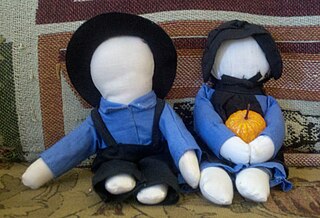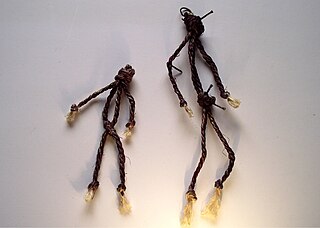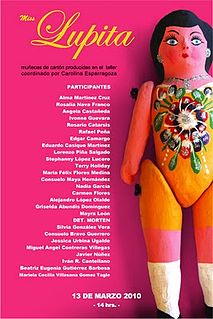 W
WAfrican dolls across the continent are created for young girls to play with and as a charm to ensure fertility in women. Their shape and costume vary according to region and custom. Frequently dolls are handed down from mother to daughter. Western dolls are popular in Africa and are often dressed with traditional garb.
 W
WAkua'ba are wooden ritual fertility dolls from Ghana and nearby areas. The best known akua'ba are those of the Ashanti people, whose akua'ba have large, disc-like heads. Other tribes in the region have their own distinctive style of akua'ba.
 W
WAmish dolls are a type of rag doll and a popular form of American folk art, which originated as children's toys among the Old Order Amish people. While some Amish dolls have faces, the best-known ones do not, to emphasize the fact that all are alike in the eyes of God.
 W
WAn apple doll, also known as an apple-head or applehead doll, is a North American folk craft in which the doll's head is made from dried apples. In modern times, apple dolls are mostly used as decorations or to display craftsmanship, rather than as children's toys. Because of the different effects drying produces, no two dolls are alike.
 W
WA corn husk doll is a Native American doll made out of the dried leaves or "husk" of a corn cob. Maize, known in some countries as corn, is a large grain plant domesticated by indigenous peoples in Mesoamerica in prehistoric times. Every part of the ear of corn was used. Women braided the husks for rope and twine and coiled them into containers and mats. Shredded husks made good kindling and filling for pillows and mattresses. The corncobs served as bottle stoppers, scrubbing brushes, and fuel for smoking meat. Corn silk made hair for corn husk dolls. Corn husk dolls have been made by Northeastern Native Americans probably since the beginnings of corn agriculture more than a thousand years ago. Brittle dried cornhusks become soft if soaked in water and produce finished dolls sturdy enough for children's toys. Making corn husk dolls was adopted by early European settlers in the United States of America. Corn husk doll making is now practiced in the United States as a link to Native American culture and the arts and crafts of the settlers.. In some Pagan faiths, corn dollies are used to celebrate Lammas. Corn dollies are magickal charms thought to protect the home, livestock, and personal wellness of the maker and their family. They may be a home for the spirit of the crop. The tradition pertains to the idea that the crop of grain has a spirit that loses its home after the final harvest and it is therefore to be invited and housed in the home over the winter before being returned to the earth in spring for the next crop.
 W
WThe golliwog, golliwogg or golly is a doll-like character – created by Florence Kate Upton – that appeared in children's books in the late 19th century, usually depicted as a type of rag doll. It was reproduced, both by commercial and hobby toy-makers, as a children's toy called the "golliwog", a portmanteau of golly and polliwog, and had great popularity in the UK and Australia into the 1970s. The doll is characterised by black skin, eyes rimmed in white, red lips and frizzy hair.
 W
WHopi katsina figures, also known as kachina dolls, are figures carved, typically from cottonwood root, by Hopi people to instruct young girls and new brides about katsinas or katsinam, the immortal beings that bring rain, control other aspects of the natural world and society, and act as messengers between humans and the spirit world.
 W
WInuit dolls are made out of soapstone and bone, materials common to the people of northern Alaska, Greenland and Northern Canada. Many are clothed with animal fur or skin. Their clothing articulates the traditional style of dress necessary to survive cold winters, wind, and snow. Dolls could have been gifts to young Inuit girls, to be used as teaching devices and passing down of culture. With these dolls, young girls learn various skills necessary for their survival such as skin preparation, cutting & sewing, proper use of materials, designs and significance of symbols in their cultures. Inuit dolls were enjoyed by both young and old Inuit individuals and give an excellent insight into Inuit culture.
 W
WA kitchen witch, sometimes called a cottage witch or a "Scandinavian" kitchen witch doll, is a poppet or homemade doll resembling a stereotypical witch or crone displayed in residential kitchens as a good luck charm and to ward off bad spirits.
 W
WLupita dolls, also known as cartonería dolls, are toys made from a very hard kind of papier-mâché which has its origins about 200 years ago in central Mexico. They were originally created as a substitute for the far more expensive porcelain dolls and maintained popularity until the second half of the 20th century, with its availability of plastic dolls. Today they are made only by certain artisans’ workshops in the city of Celaya, as collectors’ items. Since the 1990s, there have been efforts to revitalize the crafts by artists such as María Eugenia Chellet and Carolina Esparragoza sponsored by the government to maintain traditional techniques but update the designs and shapes.
 W
WMatryoshka dolls are a set of wooden dolls of decreasing size placed one inside another. The name matryoshka, literally "little matron", is a diminutive form of Russian female first name "Matryona" (Матрёна) or "Matryosha".
 W
WPaddle dolls are a type of ancient Egyptian female figurine that have been excavated from various tombs. Paddle dolls have been found in burials from the late Sixth Dynasty to the Thirteenth Dynasty; however, the period of their greatest popularity seems to have been the late Eleventh and early Twelfth Dynasties. Paddle dolls are made of thin pieces of wood which depict the torso of a woman with thick “hair” represented by small beads strung along string.
 W
WPaper dolls are figures cut out of paper or thin card, with separate clothes, also made of paper, that are usually held onto the dolls by paper folding tabs. They may be a figure of a person, animal or inanimate object. Paper dolls have been inexpensive children's toys for almost two hundred years. Today, many artists are turning paper dolls into an art form.
 W
WPeg wooden dolls, also known as Dutch dolls, are a type of wooden doll from Germany. They originated as simple lathe-turned dolls from the Val Gardena in the Alps. These dolls were sold undressed. Children would then make their clothing from scraps of fabric.
 W
WPetrushka is a stock character of Russian folk puppetry. Italian puppeteers introduced it in the first third of the 19th century. While most core characters came from Italy, they were soon transformed by the addition of material from the Russian 'lubki' and 'intermedii.' Petrushkas are traditionally marionettes, as well as hand puppets. The character is a kind of a jester distinguished by his red dress, a red kolpak, and often a long nose.
 W
WIn folk magic and witchcraft, a poppet is a doll made to represent a person, for casting spells on that person or to aid that person through magic. They are occasionally found lodged in chimneys. These dolls may be fashioned from such materials as a carved root, grain or corn shafts, a fruit, paper, wax, a potato, clay, branches, or cloth stuffed with herbs with the intent that any actions performed upon the effigy will be transferred to the subject based on sympathetic magic. Poppets are also used as kitchen witch figures.
 W
WMiss Lupita is a project based in Mexico City with the aim of reviving the traditional craft of Lupita dolls. The dolls originated in the late 18th and early 19th century as a way to cheaply copy more expensive imported dolls for poorer families. The dolls are made from a very hard form of papier-mâché called “cartonería” which is also used to create alebrijes and skeletal figures for Day of the Dead. However, the craft has waned with the only workshops making and selling them located in Celaya in the state of Guanajuato, mostly as collector’s items. The project’s aim was to create more contemporary designs through a series of free workshops to the public. The resulting dolls have been displayed in Mexico City, Japan and Portugal and featured in a number of Mexican publications.
 W
WA rag doll is a children's toy. It is a cloth figure, a doll traditionally home-made from spare scraps of material. They are one of the oldest children's toys in existence. Today, many rag dolls are commercially produced to simulate the features of the original home-made dolls, such as simple features, soft cloth bodies, and patchwork clothing.
 W
WThe Thanjavur doll is a type of traditional Indian bobblehead or roly-poly toy made of terracotta material. The centre of gravity and total weight of the doll is concentrated at its bottom-most point, generating a dance-like continuous movement with slow oscillations. These toys are traditionally handmade, finished with detailed, painted exteriors. They have been recognized as a Geographical Indication by the Government of India as of 2008-09.
 W
WPeg wooden dolls, also known as Dutch dolls, are a type of wooden doll from Germany. They originated as simple lathe-turned dolls from the Val Gardena in the Alps. These dolls were sold undressed. Children would then make their clothing from scraps of fabric.
 W
WYup'ik doll is a traditional Eskimo style doll and figurine form made in the southwestern Alaska by Yup'ik people. Also known as Cup'ik doll for the Chevak Cup'ik dialect speaking Eskimos of Chevak and Cup'ig doll for the Nunivak Cup'ig dialect speaking Eskimos of Nunivak Island. Typically, Yup'ik dolls are dressed in traditional Eskimo style Yup'ik clothing, intended to protect the wearer from cold weather, and are often made from traditional materials obtained through food gathering. Play dolls from the Yup'ik area were made of wood, bone, or walrus ivory and measured from one to twelve inches in height or more. Male and female dolls were often distinguished anatomically and can be told apart by the addition of ivory labrets for males and chin tattooing for females. The information about play dolls within Alaska Native cultures is sporadic. As is so often the case in early museum collections, it is difficult to distinguish dolls made for play from those made for ritual. There were always five dolls making up a family: a father, a mother, a son, a daughter, and a baby. Some human figurines were used by shamans.